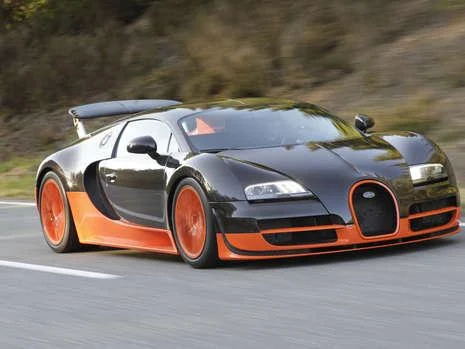Bugatti Veyron Super Sport
 |
| image is taken from motorauthority.com |
A new version of the French supercar, the Bugatti Veyron Super Sport 16.4, was unveiled in 2010. Compared to the "regular" Veyron, the new model is faster and more powerful. By adding more turbines and an intercooler, the team of engineers was able to significantly enhance the power.
They also made use of an upgraded exhaust system. The most well-known sports model that most people are familiar with is undoubtedly this specific vehicle. Additionally, the supercar was recognized as the world's fastest production vehicle. All of the models are Bugatti.
Exterior
Although many enthusiasts adore the Bugatti Veyron Super Sport's design, some feel that the vehicle lacks any aggressive features. And while it isn't really a severe issue, this problem does exist to some extent. On the exterior's aerodynamic properties, engineers labored diligently. Even yet, the vehicle includes air intakes that reduce its aerodynamic efficiency. They are necessary to cool the power unit, thus you cannot refuse them in any way.
The Bugatti Veyron 16.4 Super Sport's front end features two sizable air vents that cool the front brakes, narrow halogen headlamps, and welded relief forms. A large grille with chrome accents is present on the front end. The "sports" variant may be identified from the "regular" version from the exterior thanks to two-tone body paint.
The French supercar's side features significantly inflated wheel arches and another sizable air inlet that enters the engine bay directly. The spherical fuel tank lid on the Bugatti Veyron Super Sport 16.4's top is made of polished "winged metal." The height above the ground clearance is 99 millimeters.
It is impossible to describe the car as being the most exquisite or colorful because the firm first and foremost aimed to fascinate the driver. Although a lot of the novelty's outward muscle was lost for aerodynamics. Four sleek, contemporary optics with a rounded shape can be seen on the stern. The grilles, which are located below them and are intended to release hot engine air, are located there.
A diffuser and a sizable, square-shaped exhaust pipe are also present. Additionally, there is an engine compartment with two side air intakes that take air from above and a retractable spoiler at the top.
Interior
The French supercar's interior has premium trim materials including leather, Alcantara color, and chrome inlays. It's great that the buyer can pick the color as well as the finishing components. The driver is immediately in front of a three-spoke steering wheel. The dashboard follows, which contains analog gauges. A large tachometer can be found in the center.
A small speedometer and the fuel level are located slightly to the right. An oil pressure gauge and a gauge that displays how many "horses" the power plant is currently using are both located on the left side of the tachometer. An arrow clock is located in the central console's upper portion, below which ventilation system deflectors in the shape of circles were added.
The emergency button is located between them. A rather straightforward yet elegantly made audio system control panel is located underneath it. There is even a CD slot below. Additionally, there is the already well-known block and the "music" control block; however, it already controls the climate system. Everything continues to move smoothly toward the tunnel, which has a robotized gearbox selector.
The keys for turning on various systems and heating chairs are located close by. The modest panel is completed by the button that starts the engine. Good seats with excellent lateral support are available in the Bugatti Veyron Super Sport. They assist in maintaining the passengers' bodies through corners.
Almost everyone may set their own comfortable seat thanks to the electrically adjustable seats themselves. The front of the vehicle has a luggage compartment. Although it is not the largest, keep in mind why this hypercar was developed in the first place.
Engine and Transmission
The W-shaped turbocharged (4 turbos) 16-cylinder, 8-liter engine that propels this French supercar can produce 1,200 horsepower (1,500 Nm). This enables the car to pass the first hundred in just 2.5 seconds. 407 kilometers per hour is the maximum permitted speed. The faster, more potent model claims a speed of 415 kilometers per hour.
In city driving, the Bugatti Veyron Super Sport uses approximately 40 liters of AI-98 fuel, but if you drive silently, this number can be as low as 14 liters per 100 kilometers. The Super Sport model has an improved intercooler and turbocharger in addition to an upgraded exhaust system.
Engineers designed a 7-range Recardo robotized gearbox for such a potent engine, which distributes all the power to the four axles. It turns out that the "Frenchman" has a four-wheel drive system that is always engaged. Eleven sensors located within the vehicle keep an eye on the required engine cooling.



No comments:
Post a Comment